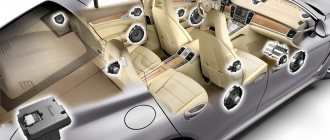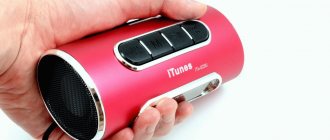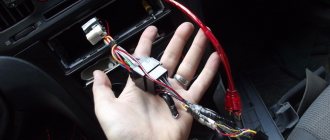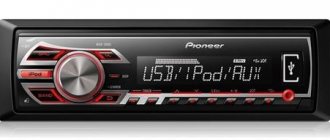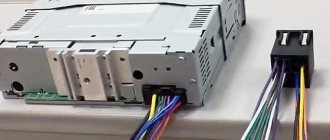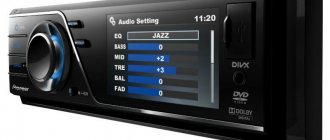Sound quality in a car is one of the most subjective factors. Most car owners are indifferent to the level of acoustics: they play and play. Another part of the drivers, usually young, equate sound quality with volume: if you can hear the windows of neighboring cars rattling, then the sound is good. Well, and the minimum percentage behind the wheel are music lovers who are able to hear the falsity of the fifth violin on the left in a concert recording. Generally speaking, there are more lovers of high-quality car audio among owners of more expensive cars, who are more demanding about every aspect of the car. It is for them that automakers make optional premium acoustics, and all kinds of tuning studios offer options for modifying standard systems. Specialists from the Bloodhound studio showed and told us how to improve the sound in a car.
To begin with, it’s worth explaining what car audio improvement is and how the process of selecting certain components occurs. As manager Ilya Smirnov notes, if the client does not have experience and knowledge in the relevant topic, he can be offered a very wide range of solutions: from standard to exclusive.
Customers often trust specialists to select the equipment that will be installed on their car, because in addition to their experience, they can guarantee the constant availability of high-quality audio components. This is a very relevant point, taking into account the fact that many, and even leading, brands in the car audio industry have rather complex distribution and sales systems in Russia.
In addition, experts know the market situation and can select components from trusted brands, directly from official importers. This is important because most often, unknowing clients are “led” by flashy advertising and big names, not realizing that sometimes a well-known global brand has long ceased to exist and now very dubious products are sold under its guise. Specialists are called upon to protect the client from such mistakes and offer him truly high-quality equipment.
Standard speaker system without casing
An important point in the selection of components is the client’s musical preferences. Before starting to develop a plan for a car, experts make sure to clarify what type of music its owner prefers, as well as at what volume he usually listens to music. Even if you take the highest quality components and set them up perfectly for listening to calm classical music, a lover of electronics or rap is unlikely to appreciate the quality of expensive components, because volume and bass are important to him, which can be completely dispensed with in the case of classical works. Such clients need to focus on completely different technology and even sacrifice the class of equipment for the sake of more power. So the approach to the development of automotive components will be individual, even if we are talking about a standard solution.
Acoustic system after processing. All improvements will be hidden under the skin
This is why standard “music” always seems so discreet and silent: it is created based on the average musical preferences of the buyer, and it is almost impossible to create universal “music” of good quality. In addition, we must not forget that car manufacturers are always limited by such parameters as the weight of the car and the volume of the trunk, so installing, for example, a subwoofer is sometimes simply impossible.
And it will still not be possible to create a truly ideal sound in a car: the location of the components in the limited space of the car will not allow it.
Option number 1. Budget
Especially for our magazine, experts from the Bloodhound studio offered several options for the most popular business sedan in Russia. Moreover, we will consider versions with 2.0 liter and 2.5 liter engines, since the top version of the Camry with a 3.5 engine is standardly equipped with a more advanced JBL audio system.
The first and, naturally, the simplest and most inexpensive option is when the basis is taken as a ready-made solution from a well-known acoustics manufacturer, which initially offers components for specific models. This practice is very common and is not something unique: almost all the leading players in the car music world offer similar ready-made solutions.
Good value for money, for example, from the French brand Focal. The kit for Camry involves replacing the standard speakers in the doors and installing a four-channel 55 W amplifier, which is enough to spare. Installing an amplifier is mandatory, since the capabilities of the standard head unit will not be enough for the new speakers and the sound may turn out to be even quieter than it was.
The cost of the set is 60,000 rubles.
Do you need a capacitor for car audio?
Many people add a capacitor to the system. When choosing, you need to take into account that for 500 W of the rated power of the system, a capacitor with a capacity of 0.5 F is sufficient. It is better to focus on models with automation to avoid problems when connecting.
The capacitor is installed to avoid bass “dip” during peak loads, when the energy from the battery and generator becomes insufficient. I had 2 amps and a powerful sub, which made the windows shake. Without capacitor. It's just a pretty toy and most car enthusiasts don't need it. It is used only by professionals who know what it is needed for.
When an amplifier with a subwoofer is installed in the car and they play at 90-100% power, the voltage on the battery can drop significantly, because they consume a lot of power. The drawdown when the engine is running can reach 12.5-13.0 V. But the point is not in the capacitor, but in the power wires and the way they are connected. If Chinese wires are installed, the voltage drop can be significant. If we install good thick wires and ensure reliable contact, the drawdown will be minimal.
The capacitor does not protect, but only accumulates energy inside, in order to then release the accumulated power to operate the amplifiers. If you have a high-quality battery and reliable wires, then no capacitor is needed.
If there was a drawdown at the peak, the Conder instantly released the charge, and then? It will help with instant peaks, and if there is a lot of bass, it will be something to charge with. In most cases, the capacitor will turn into a beautiful barrel with a voltmeter, because It will be of no use. The cable must be of high quality and nothing more.
Option No. 3. Optimal
This implies more serious work on creating an acoustic space. Six speakers are installed in the front of the car instead of the standard two, and the total number of speakers reaches eight. A separate set of works is performed for the subwoofer, which is built into the podium in the right niche of the trunk, occupying a minimum of usable space. Of course, the components are needed at a different level. The speakers and subwoofer require separate amplifiers, with the former coming with an integrated processor.
The cost of the set is 180,000 rubles.
The proposed solutions are a kind of basis from which you can build a music system in a mid-price car.
The first is a refinement of the standard system, which will solve the problem of lack of volume, various audio distortions and noise, and add purity to the sound. The second is filling the cabin with interesting and high-quality bass for fans of electronic music. The third is a fairly advanced system with a processor, a multi-channel amplifier and a compact subwoofer for music lovers.
Of course, if you wish, you can always install more serious components (an amplifier can cost 100,000 rubles). But if we consider the balance of “sound quality per ruble spent,” then Bloodhound specialists would take these three options as a basis.
Connecting a radio without a connector
Cheap Chinese radios, as a rule, are not equipped with any connectors. Stripped wires simply come out of these, and that’s it. Let's look at how to connect the radio in this case.
The machine has a standard connector
In such situations, it is highly undesirable to cut off the connector in the car and connect the wires by twisting or soldering. It is better to buy the appropriate connector and connect it to the radio. Moreover, it will be easy to do this using the diagram on the device’s body and using the color marking of the wires as a guide.
There is no connector on the car
The most hopeless case is when there are no connectors either on the radio or in the car. However, here you can go in two ways. You can buy male and female connectors and spend some time connecting them to both the radio and the wires in the car. Or you can simply connect the wires directly, leaving this node without any connectors.
In this case, the mating ends of the wires are stripped, a heat-shrinkable tube is put on one of them, after which the wires are soldered and insulated.
Let's go through the wires themselves again and clarify some nuances not mentioned above:
- Wire “+” or “BAT” - connects through a fuse to the positive terminal of the battery. By standard it is yellow. You can use a multimeter to find the appropriate wire under the panel (if it is not marked). There must be tension between it and the mass of the turned off car. You can also run a new wire.
- The “ACC” control wire is to the positive of the ignition switch, to the positive of the battery through a button, or connects to the previous one. This wire is usually red. The return wire is checked with a multimeter. Voltage should appear and disappear between it and the ground of the car at the appropriate positions of the ignition switch.
- Wire “-” or “GND” - goes directly to the negative terminal of the battery. Standard color is black. In a car, it is looked for in the same way - a multimeter connected to the previously found positive wire and this should show the voltage.
- “FL+” or “FRONT LEFT +” - plus the front left speaker. The color is usually white.
- “FL-” or “FRONT LEFT -” - minus the front left speaker. Color – white with a stripe (further with colors and poles everything is the same).
- “FR” or “FRONT RIGHT” - front right speaker. The plus is usually gray, and the minus is the same, but with a stripe.
- “RL” or “REAR LEFT” - rear left. The wires are green.
- “RR” or “REAR RIGHT” - rear right. Purple.
Finally, let's take a quick look at how to identify unlabeled wires in your car that go to the speakers. First, let's calculate which is which, and then the polarity.
To find out which wires go to which speaker, you will need any two signal wires of the radio already connected to power and turned on. Applying them one by one to the wires going deeper, we determine by ear which speaker they are connected to. Each time we mark a pair of wires with a marker, electrical tape, a price tag, and so on.
To determine the polarity of the wires going to the speakers, you will need a AA battery and an assistant. The battery must be applied to the wires, and an assistant looks at the speaker cone. If the positive of the battery matches the positive wire of the speaker, the diffuser will deflect outward. If it’s the other way around, go inside. Again, we mark each wire, if this cannot be done by their color (cars often have homemade wiring, and all cables to the speakers are the same color.
The car radio is connected to the power supply or a separate battery in exactly the same way. If the sound is reproduced by standard car speakers, then pay attention to their power and resistance. If the sound is supplied to active household speakers, then this does not matter, since they have their own amplifier, thanks to which there will be no overload. But this is a separate topic.
What's the result?
The presented options are suitable for customers who are not ready to plunge into the wilds of car audio or participate in car audio festivals. These are some ready-made solutions that meet the needs of slightly more demanding clients who have a rough idea of what they want to get from the sound. Representative Ilya Smirnov compares the creation of a car music system with tailoring a jacket: the client must always determine what is closer to him. That is why, after finishing the work, the studio specialists suggest traveling for a couple of weeks, getting used to the music, listening to your favorite tracks, and then, if necessary, returning to refine and fine-tune the system.
Possible outcomes of incorrect connection of the radio
To begin with, let’s instill a little fear, so to speak. This is necessary to make sure that an incorrectly connected car radio does not forgive errors. Unfortunately, many people resort to searching and studying instructions after something has gone wrong. It sparkled. It started smoking. Does not work. It works, but somehow not as it should.
Therefore, here are a dozen possible outcomes of an incorrect connection of the radio, and approximate reasons why this happens:
- Nothing works (power is connected incorrectly).
- There was smoke and a characteristic smell coming from the radio (same thing).
- The screen works, but the music does not play (speakers are not connected).
- Everything works, but the radio cannot be configured (the speakers are not connected correctly).
- The settings set the day before are lost the next day (the “ACC” wire is incorrectly connected.
- The sound of the speakers is “flat”, there is no real bass (the speakers are not connected correctly).
- The radio turns off for no apparent reason (bad contacts, weak wires, not enough voltage).
- Interference is heard along with the music (same thing)
- The radio quickly drains the battery (incorrect connection of “+” and “ACC”).
- The radio fuse blows (incorrect value, overload, short circuit).
At first glance, there seems to be nothing wrong with this list. But there are often cases when the problems identified in paragraphs 1, 2 and 10 end in fire. Remember - a car battery (like a generator) is a serious source of electricity. In case of short circuits, the current that can flow through the wires corresponds to the number indicated on your battery under the guise of cold cranking current. That is, 400-600 A. And to set fire to small-section wiring and plastic items next to it, a hundred amperes for a couple of seconds is enough.
Types of existing systems
Today there are two types of equipment that are responsible for sound in a car. So, there are component systems and coaxial ones. Music lover drivers prefer component systems, as they are considered more advanced. Coaxial equipment is becoming a thing of the past because it is not capable of providing good, or at least normal, sound.
What is a component speaker system?
These acoustics are speakers placed separately. If you install them correctly, you can achieve a unique presence effect. The driver will hear every instrument. Even an inexpensive car audio system can provide high quality sound. Common sets include two low- and mid-frequency speakers, as well as two high-frequency speakers. More expensive systems have additional subwoofers.
Front and rear acoustics
The most difficult choice lies ahead here. As a budget, but still high-quality option, you can purchase models from Pioneer. Even three-band models can be found on sale inexpensively.
Not every car has space for rear speakers, but you can install them yourself. For 3000 rub. You can purchase good options with three frequency bands. As an example, we recommend looking at Kenwood products.
This is how you can easily and almost inexpensively create a budget audio system for your car. Now all that remains is to learn about installation and configuration.
Speaker selection
At first glance, choosing speakers is a difficult task for a beginner, because not all speakers can be installed in standard places, and the limitation is not so much in their overall dimensions as in the technical characteristics, or rather the frequency response.
What to look for when purchasing:
Speaker Diameter The larger the physical diameter of the speaker and magnet, the louder the sound it will produce.
Speaker sensitivity. This concept reflects, one might say, the efficiency of the speaker. The higher this number, the better and louder the speaker will play.
Speaker material
Speaker Types
Wideband speakers - reproduce the main sound band with a clear rise in the sound of mid frequencies and a fall in the lows and highs. It is impossible to achieve high-quality sound with cheap speakers.
Wideband speaker Beyma 6P200FE. Source samodelka.ru
Coaxial acoustics - has several types of designs, but the principle is the same - dividing the reproduction of the entire sound band into several speakers, each operating at a given frequency, the provision of which is entrusted to filters, the simplest of which are capacitors. Such acoustics have a common housing with two speakers, which makes it easy to install it yourself instead of standard speakers. The price category of coaxial acoustics is not high, but acceptable quality can be achieved.
Soundstream SST8.2 coaxial speaker
Component acoustics - more suitable for sophisticated listeners, because... The sound quality is significantly different due to the use of separate frequency-separated speakers, with the system requiring additional space with more problematic installation. Sometimes it is necessary to make additional podiums, and the location of the speakers greatly affects the perception of sound.
So it is very important to correctly install high-frequency “tweeters”, on which the feeling of “flight” of music depends, so they need to be installed as high as possible without obstructing the output sound because HF is easily damped. Such systems are most often made three-way, and the low-frequency components of the speakers can be installed anywhere, because the location of the low-frequency radiation cannot be determined by humans.
In most cases, they are installed on a reinforced podium near the rear window, but there are options for installing them in a door or under a facing panel, since low frequencies are poorly damped. Mid-range speakers are installed in their standard places.
Three-way component acoustics DLS C36
A subwoofer or deep bass allows you to enjoy low frequencies, so it’s almost impossible to create high-quality car audio with your own hands without it. The choice of a subwoofer is based on its design features, overall dimensions and frequency response of the speaker used in it.
this article on how to choose good acoustics.
Subwoofer selection
Determining which car speakers are best for your case should be based on the type of subwoofer, because it is the one that has the most important function of reproducing soft but powerful bass.
There is no doubt that it is much easier to buy a standard subwoofer, but installing it can create big complications, and its sound inside the car can be very different due to the resonance of the body and cladding. Therefore, true fans of high-quality car audio always make their subwoofer designs with a full selection of low-frequency speakers according to the frequency response:
- The resonant frequency (Fs) of the woofer without any acoustic design is selected as low as possible. On average, this parameter is 20-25 Hz, and speakers with a lower threshold are extremely rare, but the upper limit is 40 Hz. It is worth considering that in some cases of modifications to subwoofer designs, a very low resonant frequency becomes a hindrance, causing strong vibrations that lead to sound distortion.
- The total quality factor (Qts) of the dynamics indicates the most important factor - the radiation power at the resonant frequency, i.e. The higher the quality factor, the more the speaker produces a resonant frequency, and the lower it is, the “softer” the speaker reproduces, picking up adjacent frequencies. It is worth considering that the larger the speaker magnet, the lower the total quality factor, although this dependence is not so strict, because Qts is also influenced by other factors. When designing a subwoofer, it is necessary to take into account that a quality factor below 0.3-0.35 is considered low, and above 0.5-0.6 is considered high.
- The equivalent volume (Vas) is determined by the rigidity of the acoustic suspension of the speaker and its diameter, and the softer the suspension and the larger the diffuser, the larger the volume of the air cushion is required, because the loudspeaker with such parameters is very sensitive to external air influences. In other words, it is imperative to take this parameter into account to correctly select the volume of the subwoofer, because large soft diffusers have the prerequisites for high power output (swing), but require a large air cushion for proper operation without distortion. Therefore, speakers with the same resonant frequency and cone size, but different acoustic suspension stiffness, will sound differently in the same subwoofer enclosure.
Choosing the right speakers for a subwoofer is half the battle; a more difficult stage is calculating its size, power volume and choosing a housing:
